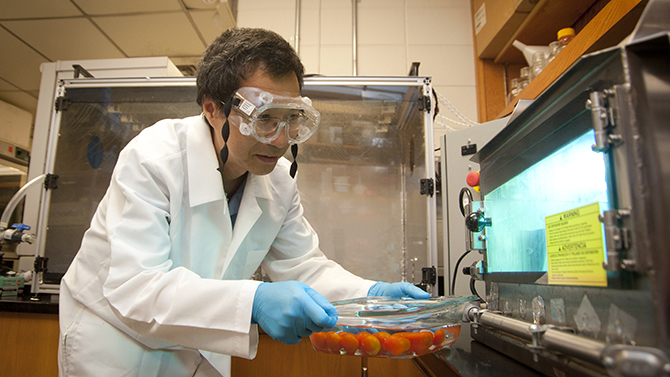


Clean produce
Photo by Wenbo Fan July 18, 2016
UD professor develops UV light oven to fight off foodborne pathogens
With foodborne illness outbreaks from harmful pathogens occurring on a yearly basis both nationally and internationally, there is a need to ensure the consumption of cleaner produce.
The University of Delaware’s Haiqiang Chen is trying to accomplish just that with his new ultraviolet (UV) light oven, a product that will combine UV light with water that is stirred up to put the cleanest produce possible on the plates of consumers.
“At home, when the fresh produce reaches you, it might not be completely free of foodborne pathogens,” Chen said. “Typically, consumers don’t wash fresh produce if it has been pre-washed, and those who do generally just wash it a couple of times with tap water. There’s been nothing that’s really effective that you can use at home to ensure clean produce, so the idea was to develop something that can be used in the home.”
Chen, professor of food science in UD’s College of Agriculture and Natural Resources (CANR), has developed the technology and is currently working with UD’s Office of Economic Innovation and Partnerships (OEIP) to patent and commercialize the innovation.
The oven will be designed to look like a domestic microwave oven and will be user-friendly, with Chen envisioning that it also could be used in restaurants, cafeterias, hospitals and commercial kitchens.
The oven will have a simple control panel to allow users to adjust treatment time and will offer a fixed UV intensity.
“The decontamination comes through two sources, UV and water. The UV will kill pathogenic bacteria and viruses but the bad thing about UV is that it doesn’t penetrate through solids, although it can penetrate through clear water,” Chen said. “The water will wash off the pathogens from a food surface and whenever they get into the water, they will be killed almost immediately.”
To test the decontamination efficacy of the oven, Chen compared it to that of simple tap water washing under two simulated salmonella pathogen contamination scenarios: spot-inoculation, where a piece of produce was contaminated in a particular spot, and dip-inoculation, which is the worst-case scenario and involves the entire piece of produce being contaminated.
Using lettuce, spinach, tomato, blueberry and strawberry samples, Chen found the UV light oven to decontaminate fresh produce much more effectively than tap water washing. In the case of the dip-inoculated lettuce, the oven could kill 99.7 percent of the salmonella population while the tap water washing could only kill 59.3 percent, greatly reducing the risk of foodborne illness.
“For spot inoculation, the UV is a lot better. It showed a lot of reduction. It can kill 99.999 percent of salmonella spot-inoculated on tomatoes – it’s basically gone,” said Chen.
Lest the word “oven” scare users away, Chen said that this method will not heat the produce in any way and will not have a negative effect on its sensory properties.
“The produce will be cold. You put it in and take it out, and nothing about the taste changes,” Chen said.
Contact Us
Have a UDaily story idea?
Contact us at ocm@udel.edu
Members of the press
Contact us at 302-831-NEWS or visit the Media Relations website

